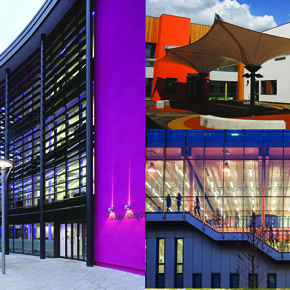
Achieving best practice: how to select the optimum building solution
Nick Milestone, managing director of B & K Structures, offers his perspective on how to select the optimum building solution to meet the budget and specific needs of the client in the April 2016 issue of PSB Magazine…
Meeting the brief
Every project is unique – the client’s brief influences each design decision. Defining key drivers is therefore crucial in establishing the desired project outcomes.
If the client intends to occupy the building for years to come, the brief may vary from developers with a remit to achieve a quick and efficient sale or – in the case of supermarkets – start trading and generating revenue as soon as practically possible.
There are numerous routes to take along the design and construction journey – selecting the core structural solution is one of the most important decisions. Structural timber systems, in my view, can tick many of the build and performance boxes.
Achieving optimum performance
 By taking an holistic approach to building design and construction, contractors can transform traditional projects into more cost-effective, energy-efficiency developments that improve the bottom line.
By taking an holistic approach to building design and construction, contractors can transform traditional projects into more cost-effective, energy-efficiency developments that improve the bottom line.
The envelope needs to work for the owners and occupiers to ensure it is energy-efficient, low maintenance and provides a comfortable environment when the building is in use.
There are many factors involved in achieving this – not only those that are visible. Considerations such as thermal performance, acoustic resistance, acoustic absorption, airtightness and fire performance are all important factors when considering the build.
Timber is uniquely placed to deliver on requirements, not only for its sustainable credentials and aesthetic appeal but also its structural strength and adaptability.
The benefits of BIM
BIM is a key enabler for integrating off-site technology and on-site construction practices – resulting in the delivery of low cost, low carbon assets.
This is crucial for Government projects, as there is a prerequisite for time-efficient construction, as well as a vital responsibility to reduce our carbon outline through the application of low energy buildings – resulting in lower costs for the end user.
BIM goes beyond the planning, design and construction phases to the whole lifecycle analysis of the project and can provide the end user with information from conceptual ideas and building design to cost control and construction management.
Design for Manufacturer and Assembly (DfMA)
By taking full advantage of off-site manufacturing techniques and exploiting Design for Manufacturer and Assembly protocols – structures can be optimised in term of budget, sustainability health and safety, time scales and performance.
DfMA is used as the foundation for concurrent engineering processes to simplify and reduce manufacturing and assembly costs, with quantifiable improvements.
Measuring best value
Value engineering in construction has enormous benefits to both developers and clients alike. The multi-step process is an integral part of the design and development stages and is aimed at increasing value.
The time invested in value engineering produces results. Clients who define specific criteria for measuring value in the initial planning phase experience increased satisfaction with the finished product and a reduction in overall project cost.
Value engineering can be a cost-saving measure. However, it is also becoming a respected project management technique that addresses all aspects of the building lifecycle – from initial construction through to the sustainability of sourced materials and utility efficiencies of the final project.
Positive environmental factors and social impact solutions include methods for reducing the carbon outline of transportation, building and operation, as well as suggestions that positively affect the safety and wellness of the workforce and surrounding communities.
Initial upfront investment in a robust, airtight building, will reap benefits in the long term from reduced maintenance and running costs – vital for public buildings such as schools and hospitals.
Housing developers, retailers and commercial end users have a different set of priorities with speed of construction rating one of the highest. Optimised hybrid structures offer a rapid return on investment for developers, together with delivering a quick and efficient build process for the retail and commercial sector – getting buildings on stream and operational in the optimum time.
Read the April 2016 issue of PSB Magazine
Latest news

21st February 2025
ASSA ABLOY EMEIA: Save valuable time and money with a seamless switch to programmable digital keys
In 2025, access management can be a whole lot easier. By making access part of their digital processes, businesses can put time-consuming key management and the cost of changing the locks firmly behind them. Making this switch is a lot easier than many people think, as ASSA ABLOY explains here…
Posted in Access Control & Door Entry Systems, Architectural Ironmongery, Articles, Building Industry News, Building Products & Structures, Building Services, Doors, Facility Management & Building Services, Health & Safety, Information Technology, Innovations & New Products, Retrofit & Renovation, Security and Fire Protection
21st February 2025
Showersave supports industry leaders in addressing Part L and Part G regulations
Showersave has sponsored and participated in a recent Building Insights LIVE roundtable on ‘Water & Energy Saving Innovations in New Build Housing’.
Posted in Articles, Bathrooms & Toilets, Bathrooms, Bedrooms & Washrooms, Building Associations & Institutes, Building Industry Events, Building Industry News, Building Products & Structures, Building Regulations & Accreditations, Building Services, Exhibitions and Conferences, Interiors, Pipes & Fittings, Plumbing, Retrofit & Renovation, Sustainability & Energy Efficiency
21st February 2025
GEZE: The importance of Specifying High Quality Door Closers on Fire Doors
Andy Howland, Sales & Marketing Director at GEZE UK, discusses why specifying high quality door closers on fire doors is important…
Posted in Access Control & Door Entry Systems, Accessibility, Architectural Ironmongery, Articles, Building Industry News, Building Products & Structures, Building Regulations & Accreditations, Building Services, Doors, Facility Management & Building Services, Health & Safety, Posts, Restoration & Refurbishment, Retrofit & Renovation, Security and Fire Protection
21st February 2025
Insight Data achieves ISO9001 recertification with zero non-conformities
Leading industry data specialist, Insight Data, has successfully achieved the prestigious recertification for ISO9001 with zero non-conformities for the fourth consecutive year.
Posted in Articles, Building Industry News, Building Regulations & Accreditations, Building Services, Information Technology, Research & Materials Testing
 Sign up:
Sign up: